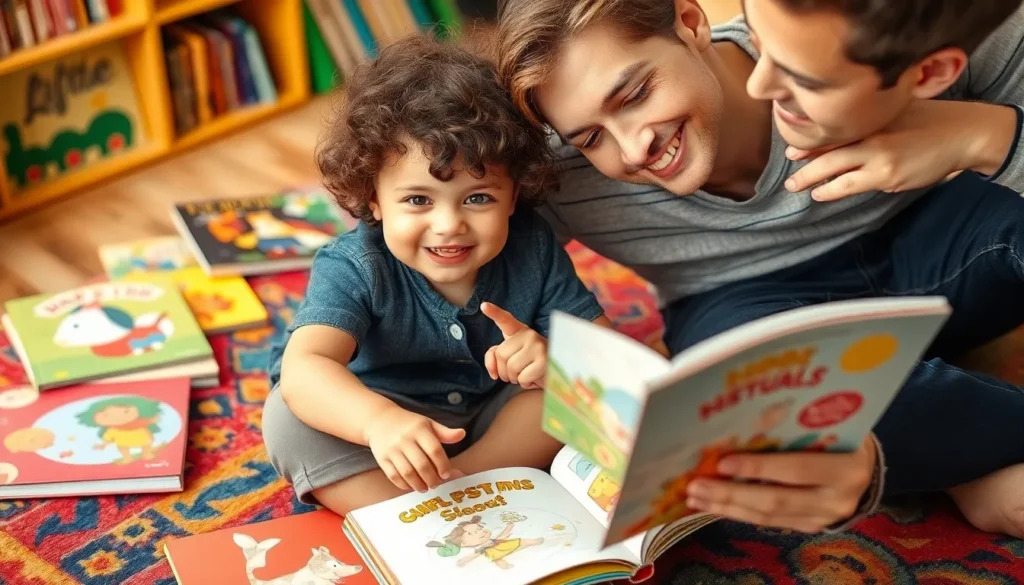Table of Contents
ToggleWhen it comes to toddler books, choosing the right ones can feel like navigating a jungle filled with colorful creatures and unpredictable plot twists. These little pages hold the power to spark imagination, build vocabulary, and even create lifelong readers—if only the right titles are picked. Who knew that a book about a hungry caterpillar could lead to a full-blown obsession with vegetables?
Benefits Of Reading Toddler Books
Reading toddler books presents numerous advantages for early development. Engaging with literature helps nurture various essential skills in young children.
Early Language Development
Reading to toddlers cultivates crucial language skills. Vocabulary expands as children are exposed to new words and sentence structures. Hearing stories encourages them to mimic sounds and learn pronunciation. Interactive books, such as those with flaps or textures, stimulate expressive language. Through repetition of phrases and sentences, toddlers gain confidence in their verbal abilities. Additionally, conversations about the stories foster their comprehension skills.
Cognitive Skills Enhancement
Cognitive skills benefit significantly from reading toddler books. Problem-solving abilities improve as children encounter diverse scenarios within stories. Following plots helps enhance memory retention and sequential thinking. Activities like asking questions about the story stimulate critical thinking and reasoning. Engaging with illustrations also promotes visual literacy and interpretation skills. Overall, these experiences lay a solid foundation for lifelong learning and inquiry.
Types Of Toddler Books

Understanding the various types of toddler books can help caregivers make informed choices. Each type serves unique purposes and offers distinct benefits.
Board Books
Board books feature sturdy pages that resist tearing, making them ideal for toddlers. These books often include simple images and limited text, capturing young children’s attention. Bright colors and engaging illustrations stimulate visual development. Many board books also encourage tactile exploration through textures and flaps, enhancing sensory experiences. This format allows toddlers to handle books independently, fostering a love for reading early on.
Picture Books
Picture books combine illustrations with narratives, appealing to toddlers’ imaginations. Through vibrant images, these books help convey story concepts, making comprehension easier. Often, picture books introduce themes such as friendship and adventure, promoting social and emotional understanding. Caregivers can use these stories for shared reading experiences, strengthening bonds while supporting language development. A variety of genres ensures there’s something for every young reader’s interest.
Interactive Books
Interactive books engage toddlers through features like lift-the-flap or touch-and-feel elements. These books encourage participation, making reading a fun activity. As children interact with the story, they develop fine motor skills and hand-eye coordination. The questions and prompts within many interactive books spark curiosity and critical thinking. Caregivers enjoy using these books to initiate conversations, building vocabulary and comprehension skills.
Tips For Choosing The Right Toddler Books
Choosing the right toddler books involves considering various factors that ensure the material aligns with children’s developmental needs.
Consider Age Appropriateness
Selecting age-appropriate books holds great significance in engaging toddlers. Books designed for younger toddlers often feature simpler language, short sentences, and concepts that are easy to grasp. For example, books for 1- to 2-year-olds typically prioritize basic vocabulary and bright images. Books for older toddlers, around ages 2 to 3, may incorporate slightly more complex storylines and expanded vocabulary. Caregivers must assess the child’s skill level and interests when making selections. Understanding these developmental stages allows parents to promote effective learning that resonates with toddlers.
Look For Engaging Illustrations
Engaging illustrations capture toddlers’ attention and spark their curiosity. Vibrant colors and captivating artwork enhance the reading experience, making stories more memorable. Images should depict relatable scenarios and familiar objects to aid comprehension. Interactive elements, such as lift-the-flap features or textured pages, further enhance engagement by inviting participation. Well-illustrated books encourage toddlers to explore and discuss different elements, fostering conversation and language development. Caregivers should seek illustrations that not only entertain but also complement the narrative to create a rich, immersive reading experience.
Recommended Toddler Books
Selecting the right toddler books enhances the reading experience and fosters development. Below are some recommended titles that prove effective in engaging toddlers.
Classic Favorites
“Brown Bear, Brown Bear, What Do You See?” by Bill Martin Jr. captivates with its repetitive structure and vibrant illustrations. “Goodnight Moon” by Margaret Wise Brown offers a soothing bedtime routine through simple rhymes and comforting imagery. “The Very Hungry Caterpillar” by Eric Carle encourages curiosity about food and nature, integrating educational themes into a fun narrative. “Where the Wild Things Are” by Maurice Sendak sparks imagination, inviting children into a world of adventure. Each of these classics remains timeless, beloved by generations.
Recent Releases
“How to Catch a Mermaid” by Adam Wallace delights with imaginative storytelling and lively illustrations. “The Pigeon Will Ride the Roller Coaster!” by Mo Willems combines humor and excitement for a captivating reading experience. “We Don’t Eat Our Classmates” by Ryan T. Higgins fosters empathy and social skills as it explores the challenges of new environments. “Llama Llama Loves to Read” by Anna Dewdney balances storytelling with engaging artwork, promoting the joys of literacy. These recent titles stand out for their creativity and relevance, making them perfect additions to any toddler’s library.
Choosing the right toddler books is a vital step in nurturing a child’s development. Engaging stories and vibrant illustrations can spark curiosity and foster a lifelong love for reading. Caregivers have the opportunity to create meaningful experiences through shared reading, enhancing language skills and cognitive abilities along the way.
With a variety of options available from board books to interactive stories, there’s something for every toddler. By selecting age-appropriate books that captivate their interests, caregivers can support essential growth while making reading a joyful activity. Investing time in these early literary adventures lays the groundwork for future learning and exploration.







